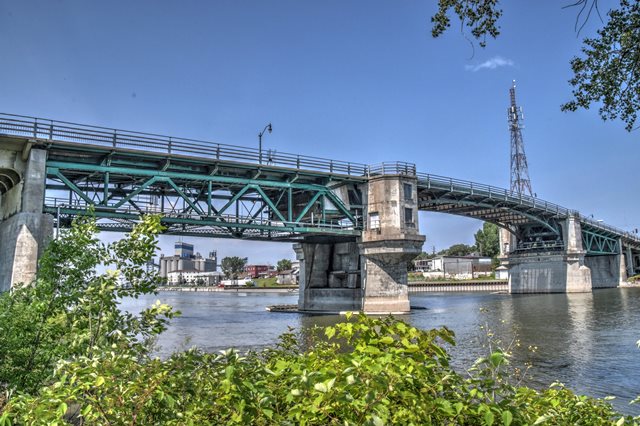We Recommend:
Bach Steel - Experts at historic truss bridge restoration.
BridgeHunter.com Phase 1 is released to the public! - Visit Now
Pont Turcotte

Primary Photographer(s): Nathan Holth
Bridge Documented: April 13, 2011 and July 5, 2019
Sorel-Tracy: Montérégie, Québec: Canada
Metal Rivet-Connected Warren Railing Height Truss, Movable: Double Leaf Bascule (Fixed Trunnion) and Approach Spans: Metal 7 Panel Rivet-Connected Deck Truss, Fixed
1932 By Builder/Contractor: Dominion Bridge Company of Montréal, Québec
2001
200.0 Feet (61 Meters)
889.0 Feet (271 Meters)
39.4 Feet (12.01 Meters)
1 Main Span(s) and 12 Approach Span(s)
Not Applicable

View Information About HSR Ratings
Bridge Documentation
This double-leaf bascule bridge is a rare example of a bascule bridge with a truss superstructure in Canada. The bridge's bascule span has trusses arranged so that it is essentially a deck truss with the trusses positioned so that they are are also above the deck slightly like a pony truss. This increases the vertical clearance under the bridge when the bridge is lowered, and it allows the trusses to function as a railing on the deck. This "railing-height" truss design was pioneered in Chicago, Illinois in 1922 on the Madison Street Bridge.
This bridge is very unusual among bascule bridges because it also displays the characteristics of a high level bridge. A substantial series of approach spans constructed at a grade provide a bascule span that crosses the river at a considerable height. Bascule bridges were typically constructed in areas where the long approach system for a high level bridge was undesirable. That this bridge still requires a movable span even at the height of its main span, indicates that large boats use this waterway. The construction of a partially high-level bridge with a movable span likely tried to combine the best of both worlds: the bridge is high enough so that it does not need to open for small boats, but for large boats that would require an enormous amount of clearance, the bridge can open to let them pass.
The approach spans are noteworthy on this bridge largely because they include an attractive deck truss approach span at each end of the bascule span. The deck truss spans are each 120 feet (26.6 meters) and are unusual because they appears to be deeper at one end, specifically the end next to the bascule span. The remaining 10 approach spans are concrete and have span lengths of 45 feet (13.7 meters).
This bridge was operated up to 400 times a year in the late 1970s. Operation dropped to less than five times a year in the 2000s. The bridge was rehabilitated extensively starting in 2001. The bridge had been damaged by collisions with boats, which complicated rehabilitation somewhat. Sadly, due to collision damage, the northern truss of the eastern approach deck truss span appears to have been completely replaced. It appears that this replacement was not in-kind, meaning that the new truss lacks details such as built-up beams with lattice. Despite alteration, the overall bridge retains its original appearance, and other areas of the bridge show less substantial loss of original material and design.
YouTube Videos showing bridge in raised position: Video 1, Video 2, Video 3.
View An Article Discussing This Bridge And A Rehabilitation Project
![]()
Photo Galleries and Videos: Pont Turcotte
Bridge Photo-Documentation
Original / Full Size PhotosA collection of overview and detail photos. This gallery offers photos in the highest available resolution and file size in a touch-friendly popup viewer.
Alternatively, Browse Without Using Viewer
![]()
Bridge Photo-Documentation
Mobile Optimized PhotosA collection of overview and detail photos. This gallery features data-friendly, fast-loading photos in a touch-friendly popup viewer.
Alternatively, Browse Without Using Viewer
![]()
Maps and Links: Pont Turcotte
Coordinates (Latitude, Longitude):
Search For Additional Bridge Listings:
Additional Maps:
Google Streetview (If Available)
GeoHack (Additional Links and Coordinates)
Apple Maps (Via DuckDuckGo Search)
Apple Maps (Apple devices only)
Android: Open Location In Your Map or GPS App
Flickr Gallery (Find Nearby Photos)
Wikimedia Commons (Find Nearby Photos)
Directions Via Sygic For Android
Directions Via Sygic For iOS and Android Dolphin Browser

